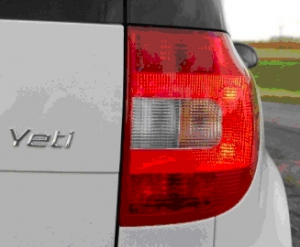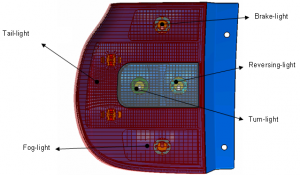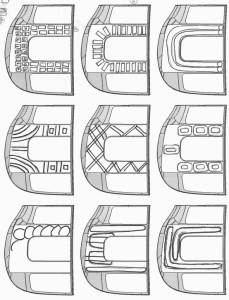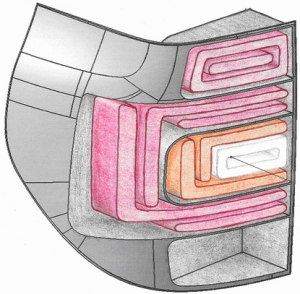Affordable rear light project
07. December, 2012, Autor článku: Rekšák Vladimír, Elektrotechnika, Študentské práce
Ročník 5, číslo 12  Pridať príspevok
Pridať príspevok
![]() This work brings the comparison and review of most widely used applications which are merging LED and lightguide technology used in the manufacture of the automotive rear signal light. The contribution also refers the new technological and design trend in automotive lighting invented by Visteon – Autopal company. This paper also compares the new invented lightguide technology and mostly used LED technologies. Last but not least shows the development and price impact of using specific modern automotive lighting technology.
This work brings the comparison and review of most widely used applications which are merging LED and lightguide technology used in the manufacture of the automotive rear signal light. The contribution also refers the new technological and design trend in automotive lighting invented by Visteon – Autopal company. This paper also compares the new invented lightguide technology and mostly used LED technologies. Last but not least shows the development and price impact of using specific modern automotive lighting technology.
1. Background
This work follows my last contribution Virtual prototyping of the automotive light, therefore it doesn’t bring detailed construction solutions of lightguide technology but it mentions to cost impact of using new technology invented by Visteon – Autopal company.
As the article Virtual prototyping of the automotive light demonstrates, some applications do not require the use of diodes, despite their lower energy consumption. Nevertheless this article also shows the same or very similar final lighting effect which can be achieved by using suitably modified lightguide system. This solutions are demonstrated in Skoda Yeti rear lamp. First solution which is based on replacing many LEDs by one LED and properly calculated light guide is applied in tail light. Second solution points to comparison of final lighting effect achieved by using LEDs and incandescent light bulb. This is greatly shown in fog and brake light of Skoda Yeti rear lamp.
2. Description of the solution
The rear light of Škoda Yeti (Fig. 1) was the object of solution in my bachelor project where we try to design the new lamp with LED diodes instead of conventional light bulbs. This is also the object of solution in my engineer project where we in detail describe light technology mentioned in this paper including total thermal and light analysis of the system and intelligence of the new Yeti lamp. Inteligence of the lamp is supplied by its own electrical control unit with ambient light sensor system which adjusts parameters of LEDs according to ambient light, vehicle speed and force on brake pedal.
First solution is based on replacing many LEDs by one high power LED and properly calculated light guide to achieve the same or very similar final light effect. At first we had to properly calculate the lightguide according to reach equal luminous flux (amount of visible light) in every light chamber of tail light system in our lamp. We measured luminous flux in lightguide using the ASAP software (Fig. 2) and modified the lightguide to ensure the best solution. Then we placed designed lightguide into the virtual lamp model which was made in CATIA software (Fig. 3).
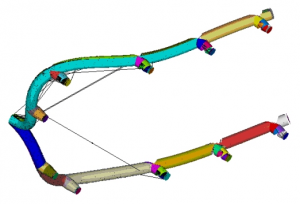
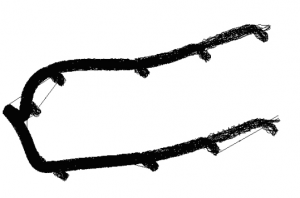
Fig. 2: Analyses in ASAP software
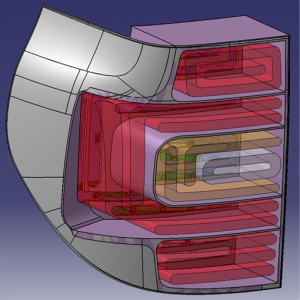
Fig. 3: Virtual model of Afforable Yeti rear lamp
Second solution which compares final lighting effect achieved by using LEDs and incandescent light bulb is based on the same shape of the lightguide system. First lightguide system, used in brake light, is illuminated by light bulb and the light passes through special designed light refractors (Fig. 4). Second light system is the same like in other known LED rear lights and in this system is applied 24 LED diodes (Fig. 5). The differences between relatively cheap system and expensive 24 LED system are greatly shown.
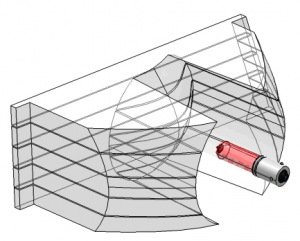
Fig. 4: Light refractors used in brake light
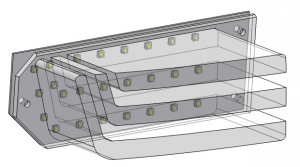
Fig. 5: LED diodes used in fog light
The main reason why we designed and invented this system was: preserve LED effect and reduce price of the lamp. The final effect of replacing 24 LED diodes with one light bulb and light refractor is shown at Fig. 6a. Price comparison is shown at Fig. 6b. In upper light is used light bulb, in lower light are used LED diodes.
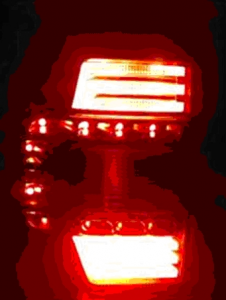
Fig. 6a: Comparison of the final lighting effect
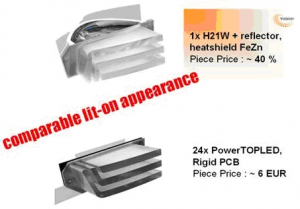
Fig. 6b: Price comparison of the design
We also compare our solution for tail light function (real model is at Fig. 7) with two other solutions which are used in rear automotive lamps in the presence. The first solution is application of LED diodes placed on flex board. The second solution shows use of LED diodes placed on standard PCB board. The conclusion is following: if the first solution (Fig. 8) represents 100% of price than the second solution (Fig. 9) could reduce the price to 75% per piece of lamp and our solution (Fig. 10) could reduce the price to 45% per piece of lamp in a mass production. This is the very interesting and enriching information not only for us but also for many car manufactories around the world.
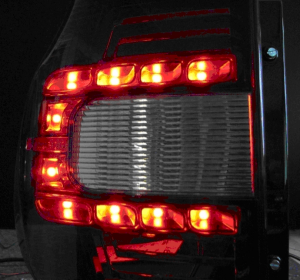
Fig. 7: Real made model of the Affordable Yeti lamp
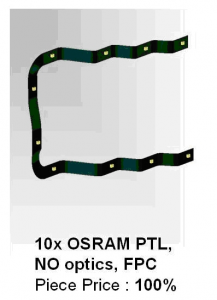
Fig. 8: Solution with LEDs placed on flexboard
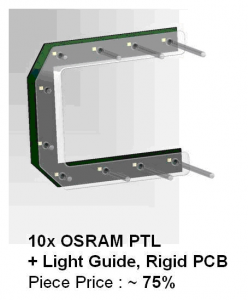
Fig. 9: Solution with LEDs placed on standard PCB
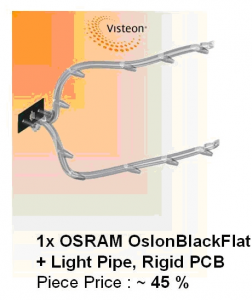
Fig. 10: Solution with one power LED and lightguide
3. Conclusion
This project was exposed and presented in many countries around the Europe and also in Asia. Every automotive company, especially Skoda company, was surprised and it is only the question of the time when this system will appear in new rear lamp in some new vehicle. Anyway we will never be sure if the lamp is based LED technology or sophisticated system with light bulbs.
4. References
- Rekšák, V.: Virtuálne prototypovanie automobilového svietidla. Bachelor project. FEI STU Bratislava 2011.
- Rekšák, V.: Konštruovanie automobilového svietidla. Engineer project. FEI STU Bratislava 201
- Fric, R.: Konštruovanie a dizajn svietidiel. Prednášky. FEI STU Bratislava 2009.
- Kropáč M., Kratochvíl J. : New trends in automotive exterior lighting, In: Svetlo 2009. Light 2009 : 18. medzinárodná konferencia. Jasná, 21.-23.10.2009. – Bratislava : Slovenská svetelnotechnická spoločnosť, 2009. – ISBN 978-80-969403-7-0.
- http://www.carliterature.files.wordpress.com/2011/11/dsc_1246.jpg
Coauthor of this paper is Ing. Róbert Fric, PhD.
